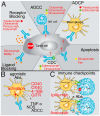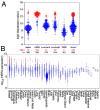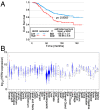Therapeutic Monoclonal Antibodies against Cancer: Present and Future
- PMID: 38132155
- PMCID: PMC10741644
- DOI: 10.3390/cells12242837
Therapeutic Monoclonal Antibodies against Cancer: Present and Future
Abstract
A series of monoclonal antibodies with therapeutic potential against cancer have been generated and developed. Ninety-one are currently used in the clinics, either alone or in combination with chemotherapeutic agents or other antibodies, including immune checkpoint antibodies. These advances helped to coin the term personalized medicine or precision medicine. However, it seems evident that in addition to the current work on the analysis of mechanisms to overcome drug resistance, the use of different classes of antibodies (IgA, IgE, or IgM) instead of IgG, the engineering of the Ig molecules to increase their half-life, the acquisition of additional effector functions, or the advantages associated with the use of agonistic antibodies, to allow a broad prospective usage of precision medicine successfully, a strategy change is required. Here, we discuss our view on how these strategic changes should be implemented and consider their pros and cons using therapeutic antibodies against cancer as a model. The same strategy can be applied to therapeutic antibodies against other diseases, such as infectious or autoimmune diseases.
Keywords: bioinformatics; cancer database analyses; cancer treatment; therapeutic antibodies; transmembrane proteins.
Conflict of interest statement
The authors declare no conflict of interest.
Figures






References
Publication types
MeSH terms
Substances
Grants and funding
LinkOut - more resources
Full Text Sources
Medical
Miscellaneous

